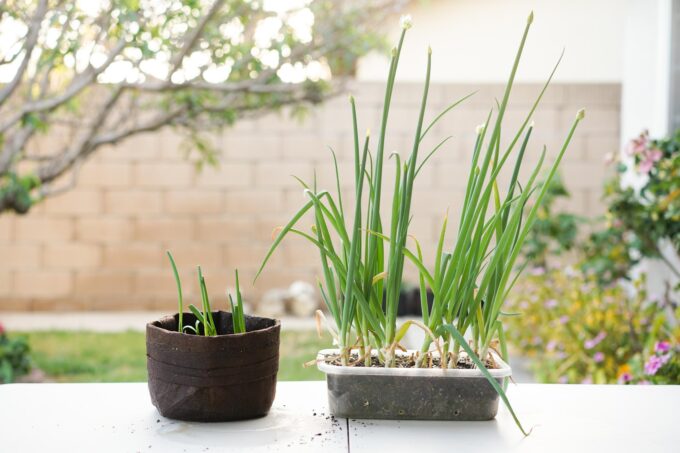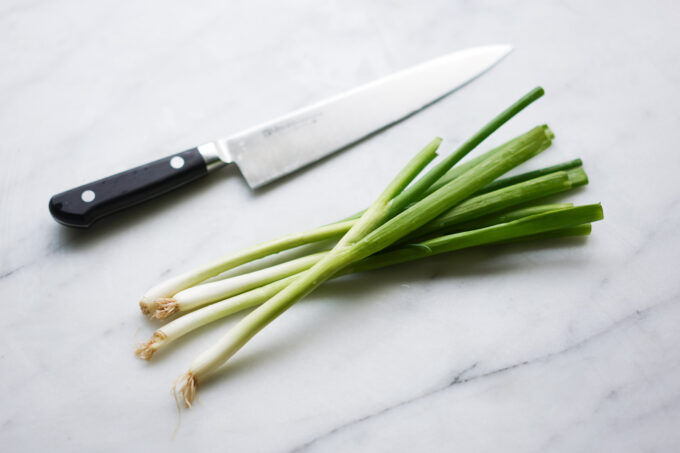If you love topping your salads or dishes with fresh green onions or scallions, then this is an easy way to make sure you always have some on hand!
The next time you use some store-bought green onions, don’t throw away the scraps–this is the gateway to grow essentially unlimited green onions. This is a good option for anyone who wants to save money and have easy access to scallions for future use.

What are green onions or scallions?
Green onions are part of the allium family of plants that include garlic, onions, and leeks. You can also find them in grocery stores labeled scallions or spring onions. They typically have thin, long green leaves with white bulbs by the roots. To learn about the differences in green onions, scallions, and chives, read about it here.

To prep green onions you can cut them up in various ways and eat almost the entire stem. The long green leaves have a mild onion taste, while the white bulbous roots have a stronger flavor (which I quite like!).
How to regrow green onions in water
To regrow green onions from scraps, all you need is the white bulbous portion with the roots intact, a cup of water, and a window near a light source. I like to leave about 1-2 inches of the white bulb to make sure it’s able to stand on its own in the cup. I typically see green onions start growing more green leaves within the first 24 hours.
Here’s some tips on regrowing green onions from cuttings:
Step 1: Cut the onions

When cutting your onions, leave about 1-2 inches of white bulbs with the roots INTACT
Step 2: Rinse the white stalks

Clean the bulbs and roots gently under running water to remove excess dirt–this keeps the water clean
Step 3: Place in a cup and add water

Use a small cup to start and add just enough water so that there’s still a bulb at the top
Step 4: Place near a bright window

Leave the cup near a window with a light source to promote growth
Step 5: Refresh the water every 2-3 days
Pour out the old water and add new tap water every 2-3 days or when the water discolors. Eventually, after a few weeks, you have the option to replant the green onions in the soil to give them more nutrients. (see below for instructions)
Planting the green onions to regrow in soil
While not completely necessary for everyone, I prefer to replant my green onions in the soil after about 1 week (or when they’re about 5 inches tall) so that the plant can get more nutrients from the soil. I found that leaving them in water to continue to grow will absolutely grow long shoots, but these shoots end up being thinner than green onions replanted in soil.
As an added benefit to replanting green onions in soil, you can also grow green onion scapes! I was pleasantly surprised to find that scapes were growing in my green onion containers after regrowing them for more than a month.
These very flavorful parts of the green onion plant (like other allium plants) is where the flower stems eventually appear for seeding. You can identify the onion scapes by a green bulb at the TOP of the stem. You can cut the entire stem and saute them to eat them.
Step 1: Rinse the onions

Remove your green onions from the glass or cup they’ve been sitting in. I like to rinse them off so they’re clean.
Step 2: Add soil to container and water

Add soil to your pot (you can use premade potting soil or your own mix). I like to water the soil before adding it into the planter so it’s already moist. This prevents the soil from moving too much when you water it later.
Step 3: Poke holes in the soil

Poke holes in the soil big enough for the green onions and leave roughly 1 1/2 inches between each hole.
Step 4: Plant the onions

Gently stick the root of the green onion down into the soil and cover about 2 inches of the white bulbs with the soil and lightly compact it so the onions won’t fall over. Depending on the size of your pot you can fit multiple green onions. For a standard 2 quart pot, I fit about 5-7 green onions.

Step 5: Water the pot and wait!

Water the container and wait for your green onions to grow. I check the soil every other day to make sure it stays moist. I like to add a bit of liquid fertilizer high in nitrogen on top to give it more nutrients. (Follow the instructions on your fertilizer if you would like to continue to give your plants more nutrients. I typically do this every 2-3 weeks).
How to harvest the green onions
Depending on how you’ve regrown your green onions (from purely water or replanted in soil), you can get between 2-5 harvests from one green onion. When you cut green onion, it regrows from layers within the original stem, so it keeps adding more layers as it grows. Sometimes these stems can be thinner than the original green onion–but I’ve found that if you replant them in soil, they will thicken up.
To harvest green onion, you can take as much of the stem as you like, but I always cut at least 1 inch above the soil and leave a little white to continue regrowing later on. Then to use them in recipes, check out the many ways to cut green onions.
Recipe ideas for green onions
Now that you’re prepped with a potentially unlimited amount of green onions, you can use them in so many recipes: Asian sesame salad dressing, yaki udon, Vietnamese scallions & oil, scallion pancakes, and more! You don’t have to stop at re-growing green onions, there are so many yummy vegetables you can start from seeds indoors in your own home.










I’ve had success planting them directly into the soil as well. I love your recipes by the way and really appreciate you sharing them.
And it works both ways with kangkong as well but you need to keep them wet.